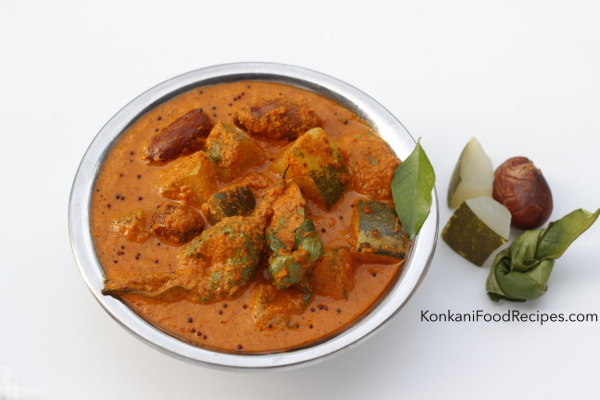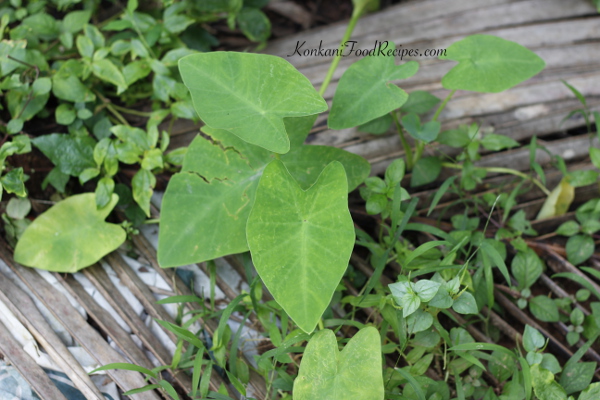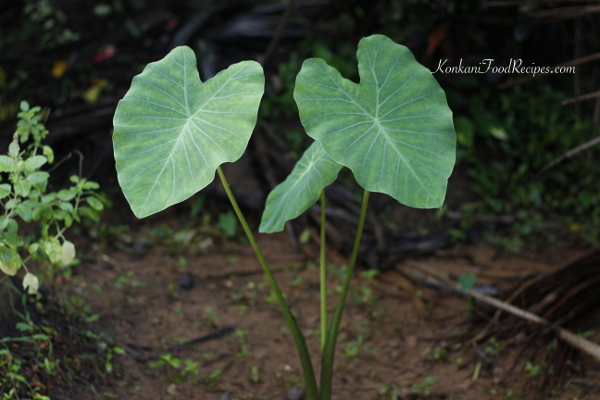Mangalore cucumber, jackfruit seeds and colocasia leaves in a Konkani style masala (Magge, Bikand, Alva Ganti Sukke)

Sukke in Konkani means dry. Sukke's are dry side dishes with veggies as the star of the dish and a thick, dry, coconut masala as the base. Konkani cuisine entails a wide variety of sukke’s prepared with a variety of veggies. A single vegetable or a combination of vegetables are usually used to prepare sukke's. This sukke here is a seasonal speciality prepared usually during the rainy season or during the end of summer. That’s when we have few showers in the coastal areas of Karnataka and as a result we have some sprouting, tender colocasia leaves perfect to go into this sukke along with some stored, jackfruit seeds from the about-to-end jackfruit season. Mangalore cucumber, cooked jackfruit seeds and colocasia leaves are a match made in heaven and when they are combined in a sweet, spicy coconut masala, the resulting sukke is absolutely delectable. Colocasia leaves used in this dish are tied into knots for ease for serving & for a nice bite size. They can otherwise be a mess while serving. :-)
Sukke’s are a great side dish for lunch/dinner. As they are spicy and sweet, they go well with dalithoy and jeere meere saar. Makes a great Konkani meal with a bowl of steaming hot rice.
Magge in Konkani means Mangalore cucumber and bikand means jackfruit seeds. Colocasia knots used in this side dish are called as alva panna ganti in Konkani.
Ingredients:
- 8-10 jackfruit seeds
- 8-10 tender, colocasia leaves
- 1/2 medium sized Mangalore cucumber/field marrow
- 1 cup grated coconut
- 1 tablespoon of urad dal
- 1 tablespoon of coriander seeds
- 1-2 tablespoons of powdered jaggery
- 5-7 dried red chillies
- 1 lemon sized tamarind
- Salt to taste
- 1 tablespoon of oil
For seasoning:
- 1/2 teaspoon of mustard seeds
- 2 tablespoons of oil
- 2 leaflets of curry leaves
Preparation Method:
1. Wash the Mangalore cucumber well. Chop it into cubes, with the peel on. In this sukke Mangalore cucumber is used with the peel on. If you don’t like them with the peel on, then you can peel them off. Make sure you deseed the Mangalore cucumber before you cube it. Keep them aside.
2. Wash tender colocasia leaves well, chop off the stem and roll the tender colocasia leaves into thin, pencil thick rolls. Then knot the rolled leaves into what we call alva panna ganti in Konkani like in the picture below. Keep the colocasia knots aside.
Colocasia leaves (Alva pann):
There are a variety of colocasia leaves. This particular colocasia variety below is perfect for using in this side dish. These tender colocasia leaves are super soft, they cook fast and get delicious, super soft soft on cooking. They are such a pleasure to eat, they're called tere paan in Konkani. They are only found during monsoons.
Or use pandavala paan, another variety of colocasia available throughout the year in abundance. The leaves of this variety are considerably soft & they cook fast enough.
This particular variety below and other varieties of colocasia leaves aren't best suited for using in this side dish. As the leaves are thick, they don't cook well enough and are a little chewy even on cooking.

Colocasia leaf knots (alva panna ganti): Colocasia leaves are knotted and are used in this recipe for a nice bite size and for ease of serving too. They can otherwise be a mess while serving. :-)
3. Pressure cook the Mangalore cucumber cubes and colocasia knots with a tablespoon of salt and 1 cup of water for just a whistle. We don’t want to overcook them.
4. Pressure cook jackfruit seeds separately with salt and 1 cup of water, until they are cooked through. Their cooking time depends on how long they've been dried for. If they're dried for more than a week, pre-soak them in water to fasten their cooking time. Should take 3-6 whistles. We want them well cooked & soft. That's when they're delicious.
5. Once jackfruit seeds cool down a little, peel them and keep them aside.
Raw jackfruit seeds (Bikand): When you buy jackfruit, wash the jackfruit seeds and use them to make this sukke.
If you plan to store the jackfruit seeds for later use, then do air dry them and then store them in an open container to prevent fungus from growing on them.
Cooked jackfruit seeds: Cook jackfruit seeds with salt, peel them and enjoy! They are absolutely amazing to eat! :-)
Cooked, peeled jackfruit seeds with it's peel:
Cooked, peeled jackfruit seeds:
Preparing the masala:
5. Heat 1 tablespoon of oil in a tempering pan, add in urad dal, coriander seeds and saute them. Add in roughly broken, dried red chilli pieces and saute them until urad dal starts to brown. Then remove them off heat and let them cool completely.
6. Once they cool, grind them along with grated coconut, tamarind and jaggery into a smooth paste, using as much water as needed. Keep the masala aside.
Preparing sukke:
7. Seasoning: Heat oil in a wok, add in mustard seeds. When they stop popping, add in curry leaves and let them sizzle for few seconds.
8. Then add in the cooked, cubed Mangalore cucumber and colocasia knots. Also, add in cooked, peeled jackfruit seeds, the ground masala and very little water if required. Check and adjust salt. The consistency of this sukke should be dry and thick in the end, so do not add excess water.
9. Mix well and let them simmer until the rawness of the masala goes off. We do need enough water in the wok to let the masala cook or else they might start sticking to the bottom of the pan before they cook through. So, make sure you've added enough water. Do saute once in a while to prevent it from sticking to the bottom of the wok.
10. Remove off heat and serve hot as a side dish, with a bowl of steaming hot rice and dalithoy.
Side Note:
1. You can make this sukke with just Mangalore cucumber & jackfruit seeds or with just colocasia leaves & Mangalore cucumber if you can't find any one of the ingredients. They taste equally awesome!
2. Do not use the water which was used to cook Mangalore cucumber, colocasia leaves or the water used to cook raw jackfruit seeds. The colocasia leaves broth tastes of colocasia and the jackfruit seeds broth will be sticky with all the gum from the seeds.
3. Any undercooked colocasia leaves present will mess with your mouth, throat and itch. Make sure the colocasia leaves are completely cooked. This recipe also calls for a little excess of tamarind to prevent any itching from the colocasia leaves. And also little extra spice and sweetness to balance the tanginess.
4. This sukke is spicy and sweet, however do add in jaggery according to your palate. Depending on how sweet you would like your sukke.
5. On cooking, the colocasia knots might open up and dissolve in the sukke. That's how they turn out to be, do enjoy them that way. They can be a little messy. :-)
6. The same sukke can be prepared by using different veggies. One such popular combination of veggies to prepare this yummy sukke is using mangoes, Mangalore cucumber and jackfruit seeds together. You can also add tender amaranthus stems and leaves.
Cook the jackfruit seeds, Mangalore cucumber like mentioned above. Add in mangoes and amarathus stems to the side dish (sukke) in step 8 along with ground masala and cook. They'll cook through fast.
Find more Konkani cuisine side dishes here.
Tags: Konkani cuisine, Konkani food, Konkani recipe, colocasia leaves, alva panna ganti, bikand, magge, sukke, side dish, Udupi cuisine, Mangalore food, alva paan.










Tweet